High School Football at a Crossroads

“Think of how far we have come in the last 20 to 30 years when it comes to concussion awareness, tackling techniques, equipment. And yet we’re still having these discussions about declining participation and safety concerns. That’s why I think why, over the next two to four years, high school football on a national level is at a critical juncture.”
—Roger Blake, executive director of the California Interscholastic Federation, the governing body for California high school sports
* * *
NEWBURY, Ohio — To get to that “critical juncture,” drive 40 miles east of Cleveland, the last few miles past country barns and rusty auto-parts shops, and you’ll come to a school, Newbury High, that loves football—but in October had to make the kind of decision coaches and administrators in many American communities are increasingly being confronted with.
In early October, Newbury High trailed a more powerful Lutheran East team 44-0 in the third quarter. A scene as uncomfortable as it is familiar played out on the field: As a Newbury Black Knight player was strapped onto a stretcher, a blanket of silence enveloped the field, mothers and fathers sorrowful in the bleachers, downcast players kneeling near their injured teammate.
Newbury began the game with 15 players. This was the fifth one lost for the game. The first four had injuries to limbs, but as this Black Knight lay motionless, paramedics intervened. Murmurs of “concussion” and “spinal injury” swept the stadium. The referees and coaches congregated. “What should we do now?” Newbury coach Tim Gladowski asked the group.
Newbury’s 11 starters usually play both ways. Now five of them were ruled out. Lutheran East had a full roster, and even during warmups its players were noticeably bulkier and taller than the Black Knights. The inequity had expanded exponentially. Perhaps, an assistant coach suggested, they could shorten the quarters. Maybe, another coach inquired, the clock could run through timeouts?
Newbury’s principal Michael Chaffee stood on the edge of the circle and finally interrupted: “Is there an option to end the game?” His question met with silence; in a sport thematically linked to battle, to toughness and determination, how could coaches tell their impressionable troops to … give up? A referee cited an Ohio rule that by agreement of administrators and the head coaches the game could be called.
“So I have the ability to stop this?” Chaffee asked.
After a pause, the officials said yes.
“OK,” Chaffee said. “I’m going to make this easy for you, coach. We’re done. I don’t foresee anything good happening in the next 17 minutes.”
A few days later the Black Knights cancelled their remaining three games. They finished the season 0-7—with anger, frustration and no resolution. The player taken to the hospital was released that night but likely would not have been cleared for the next game. It wasn’t just him. A week later Chaffee sat in on a class with another injured Black Knight. The player sneezed and instantly winced, grabbing his shoulder. Said athletic director Anthony Forfia: “We knew why we had to make this decision. What we’re grappling with now is, what does it mean going forward?”
* * *

High school football is under siege, and has been for some time. These days it barely warrants a headline when another former NFL player or coach declares he wouldn’t let a young son play the game. Concerns over safety are legitimate. Each news cycle seemingly brings reports of another study detailing the potential long-term hazards of repeated concussive and sub-concussive hits to young and developing brains. Even more chilling: This season eight teenagers have died from causes directly or indirectly related to playing the sport, and three more died after preseason practices.
But gauging the status of America’s beloved high school sports tradition in this climate is complicated. Statistics are not kept on how many schools like Newbury slash their program midseason, though it seems to be occurring more frequently. Nor is there any systematic tracking of schools that drop football or their reasons for doing so. Predicting the future is murky as well. While participation rates for high school football have declined nationwide in six of the last seven years and are down 2.5 percent overall since 2008-09, it would be premature to conclude from that stat alone that high school football is in danger. Even with that drop, there were 1.084 million boys (and some 1,500 girls) playing high school football last year, nearly twice the number of the next most popular sport, track and field. Basketball’s participation numbers are down as well from 2008-09, without any of the safety concerns associated with football; soccer, on the other hand, has seen an 11 percent rise since ’08-09 despite growing awareness of the threat of concussion in that sport.
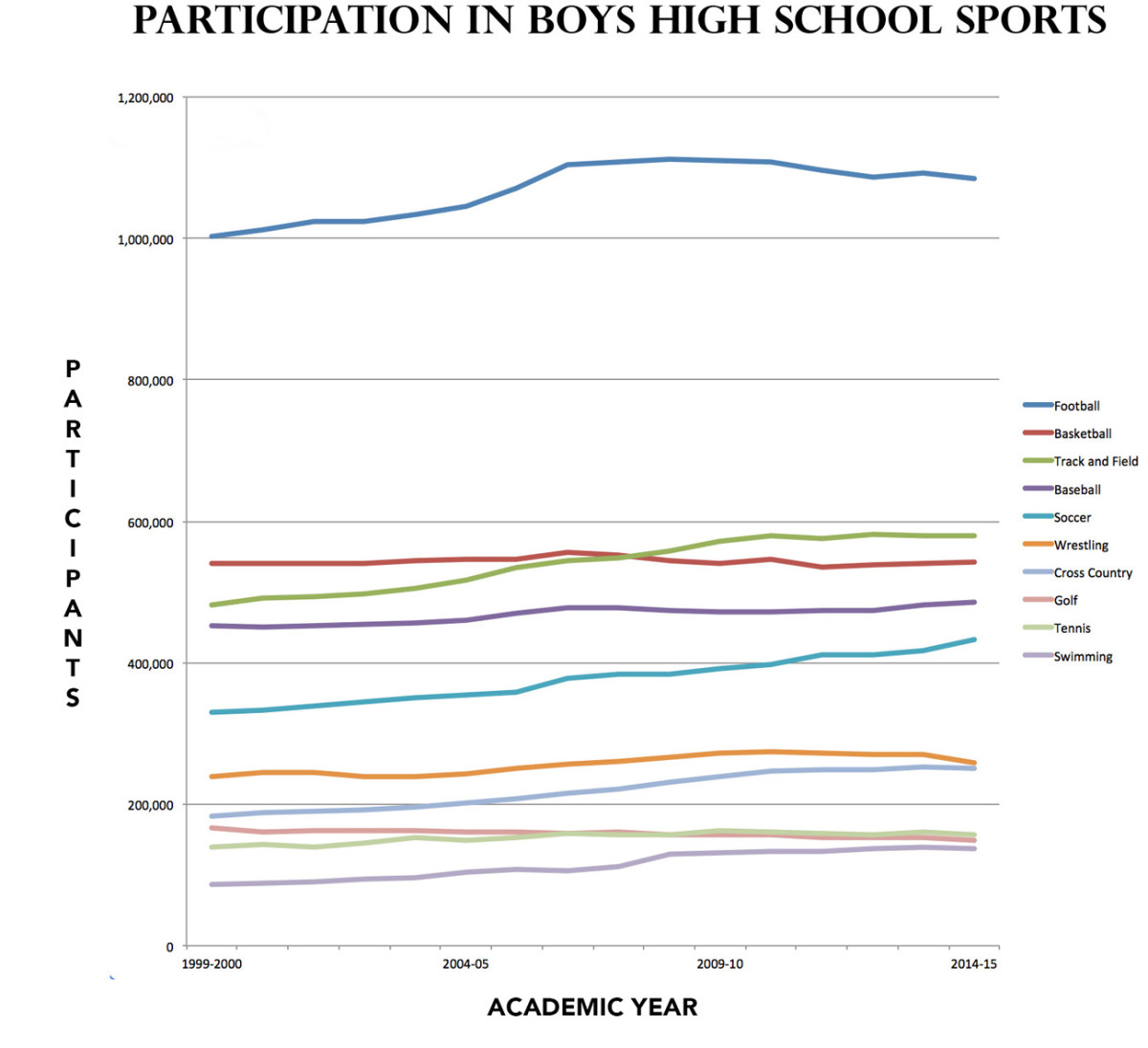
The NFHSA’s data doesn’t provide demographic or economic breakdowns of the schools that participate in football, and the raw numbers don’t factor in geography below the state level. In fact, for many states—specifically those in the South, an incubator of talent where tradition is strong—high school football is on the rise. Alabama has added 9,185 players since 2008. Louisiana is up 7,988, Oklahoma 3,657 and Texas 3,105.
That offsets the Midwest. Ohio is down 12,797 players since 2008, Wisconsin is minus 4,565, Illinois 4,060, Missouri 2,342, Minnesota 2,224 and Iowa 2,190. The MMQB talked to administrators of athletic associations in states from every U.S. region. All agree that safety concerns are one reason for football’s decline, along with the rise of specialization among young players and expanding offerings of sports (hello, varsity badminton).
But each state has a distinctive personality and set of nuances. Ohio, for example, has a pay-to-participate policy in some districts, where students are charged anywhere from $50 to $600 per co-curricular activity. “Is that discouraging young people from signing up?” asks Ohio state senator Cliff Hite, who coached high school football for 22 years. “We’re trying to find that out.” Hite is hosting a series of public forums on youth sports this month, touching on how the state’s pay-for-play policy affects participation, as well as on health issues such as sudden cardiac arrest and concussions in youth sports.
It’s clear that safety and participation are the two most pressing topics in high school football. The paradox is that most experts acknowledge that football is safer today than it has ever been. While its putative risks are not necessarily as closely linked to waning interest as is sometimes asserted, in a climate of heightened and, at times, neurotic awareness, they must be addressed for the sport to survive.
• HEAD TRAUMA IN FOOTBALL: The MMQB’s complete 2013 special report on the dangers to the game
* * *
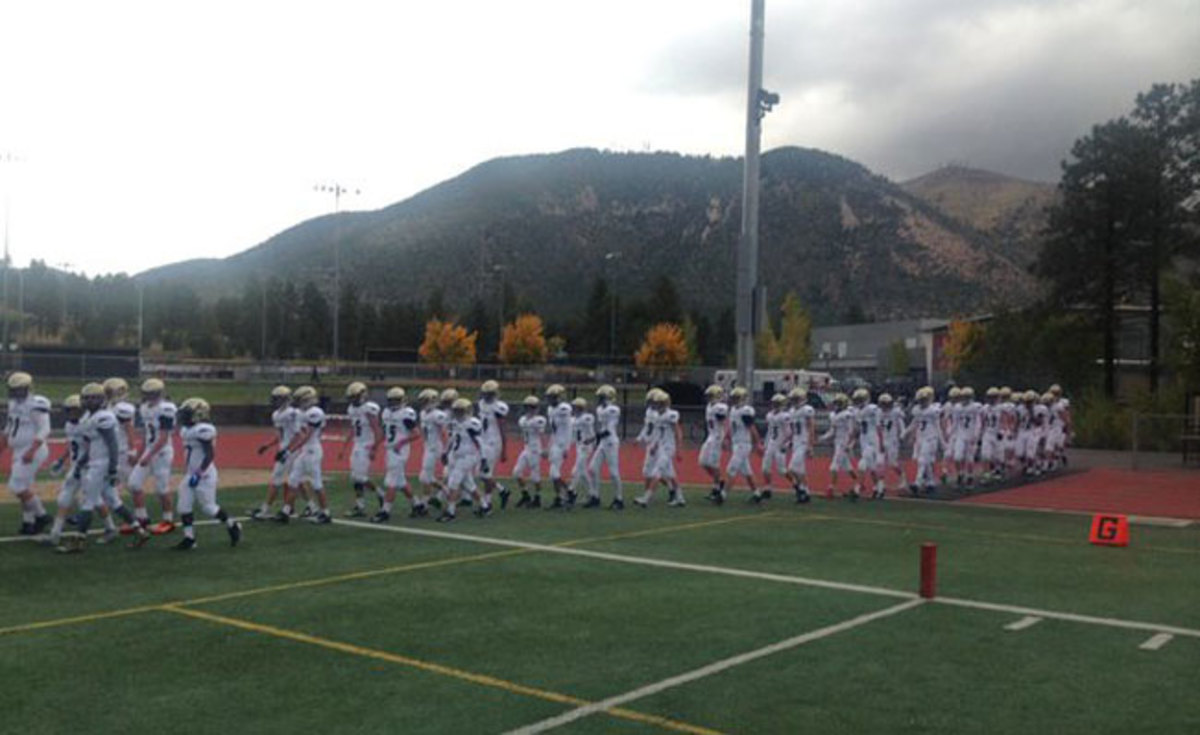
The suburbs south of Phoenix are bulging, and the schools there are adding students faster than the districts can cram desks into classrooms. This summer the Chandler Unified School District opened a new high school. The board wanted a setting that was not too big, but still offered everything. Administrators would provide as many sports as they could—22 in total. One of the first items on the agenda was the hiring of a football coach. The school tabbed a 29-year-old named Spencer Stowers from nearby Mesa Westwood High. “We never thought about not having football,” Thomas Dunn, the new assistant principal and athletic director of Casteel High said. “If the appetite is there, we want our kids to be able to play.”
The appetite was definitely there. The school didn’t yet technically own the property on which it was being constructed, and the football field barely had spades in the ground, but in April, Stowers began sending out fliers for football clinics to the local middle schools. At July tryouts, 55 boys showed up, all rising ninth graders.
“When you build a school, you’re trying to build a community. We never thought about not having football.”
Casteel opened this fall for freshman only, a total of 255 students. The school will have sophomores and freshmen next year, then graduate to three grades in 2017 and be at full capacity of around 1,200 students in 2018.
Stowers’ team competed in a freshman schedule this fall. With no home field, the Colts played some games at a sister high school in the district and the rest strictly on the road. Each time, fans filled the away stands, sometimes outnumbering the home crowd. The team hosted a veterans appreciation banquet and manned a Goodwill drive for the community.
For its last game, Casteel played on its half-constructed field. The district brought in portable bleachers that seat 950. They were overflowing. “When you build a school, you’re trying to build a community,” Dunn, the assistant principal and athletic director, said. “Our football team set that tone. It brought people together. It brought us a sense of spirit. It brought camaraderie for our students, our parents, our neighbors.”
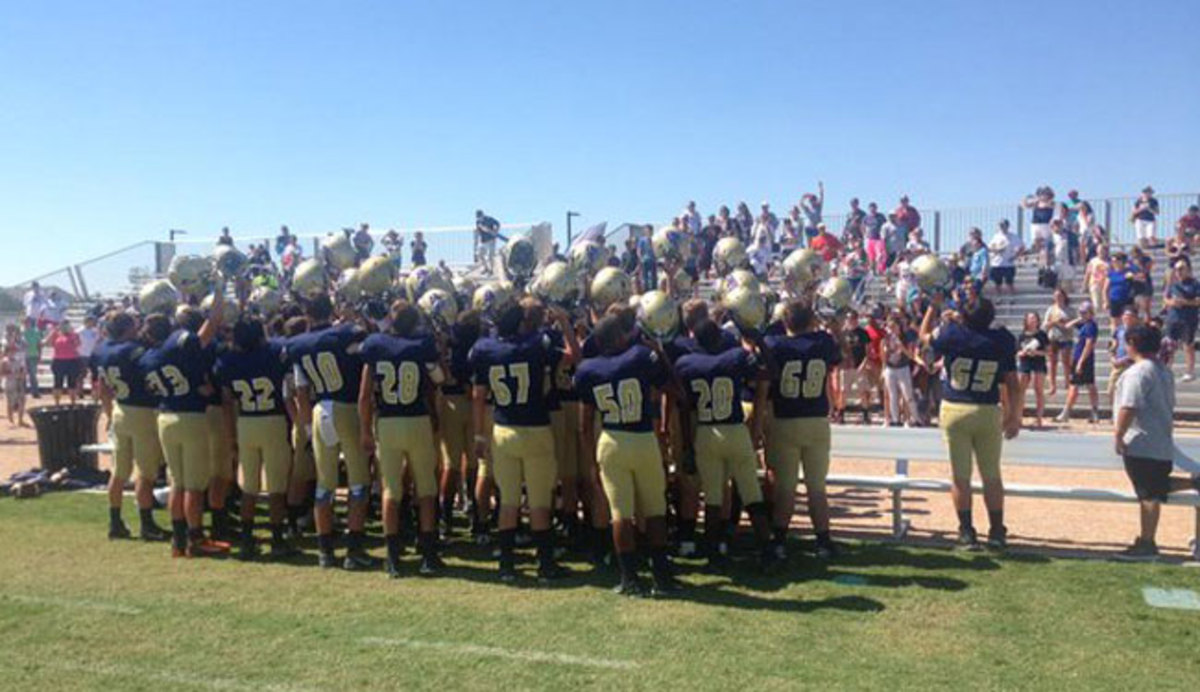
If you need to be reminded of the good in high football, think of a place like Casteel. Think of why so many coaches carve out a career in high school football. Hint: It’s not about the money. “I honestly believe that being a high school football coach is the most important job in this country right now,” said Matt Birk, the former NFL center who now works in the league office as the director of football development. Birk’s mandate is broad (and his language a bit hyperbolic), but spend an hour with him and you’ll see his passion for preserving the high school game. Throughout the year he zig-zags across the country speaking to high school coaches, meeting with experts on safety and keeping up with trends in the game.
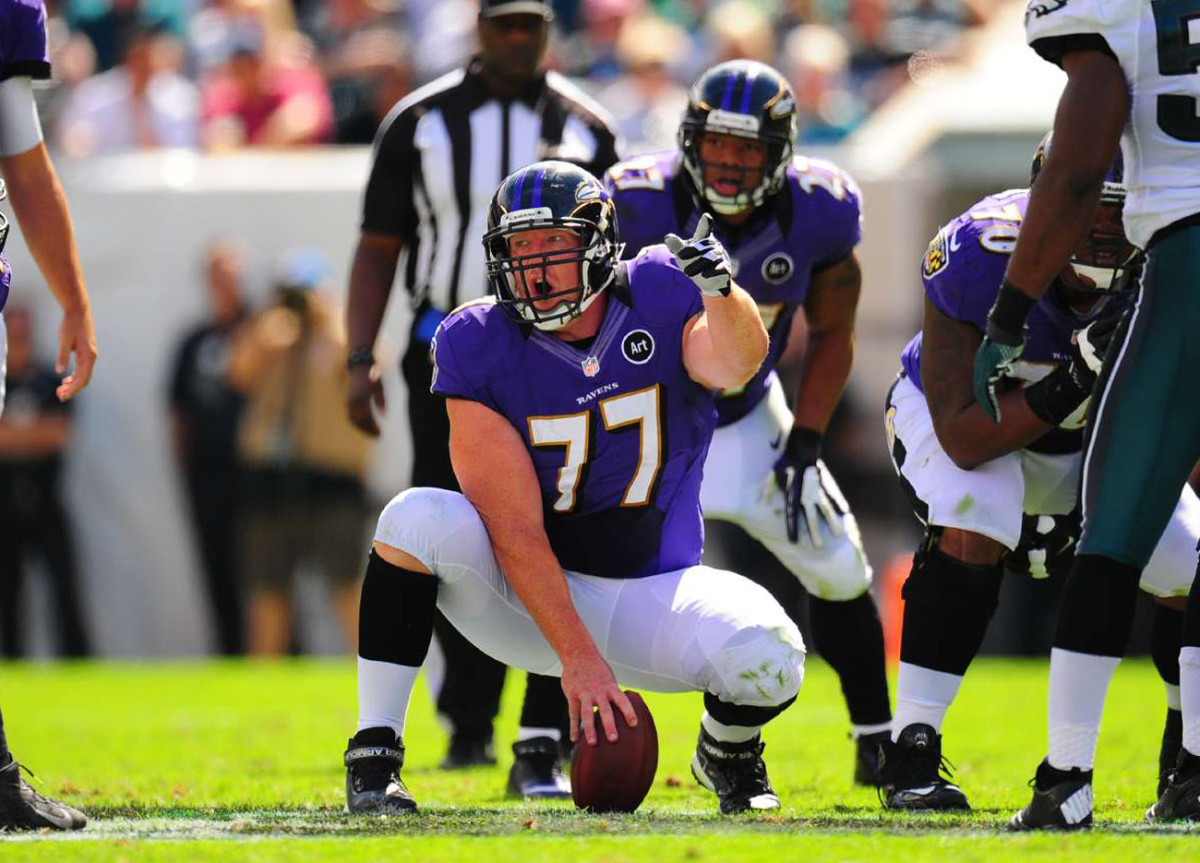
Although Birk views high school football through rose-tinted glasses—each week his inbox is flooded with feel-good stories, like the one about a high school coach in Minnesota who required his players to sing One Direction’s “That’s What Makes You Beautiful” in an appreciation of their mothers—he understands the landscape. Although football remains by far the most popular high school sport in the country, the recent decline comes in an environment in which America’s passion for the NFL remains unwavering. (Over the past decade, average viewership of NFL games on broadcast TV has risen by 25%, and last year was the second-most watched NFL season ever, after 2010.) In addition, the overall decline in high school football comes after a period of continuous growth—between 1998 and 2008, high school football nationwide went from 886,840 players to 1,112,303.
“Right now the game is under attack,” Birk said. “Part of it is our own doing, part of it is things outside of our control. That just means we have to work as hard as we can to make the game as good as it can be. As safe as it can be, as positive an experience as it can be. So how is that a bad thing?”
* * *
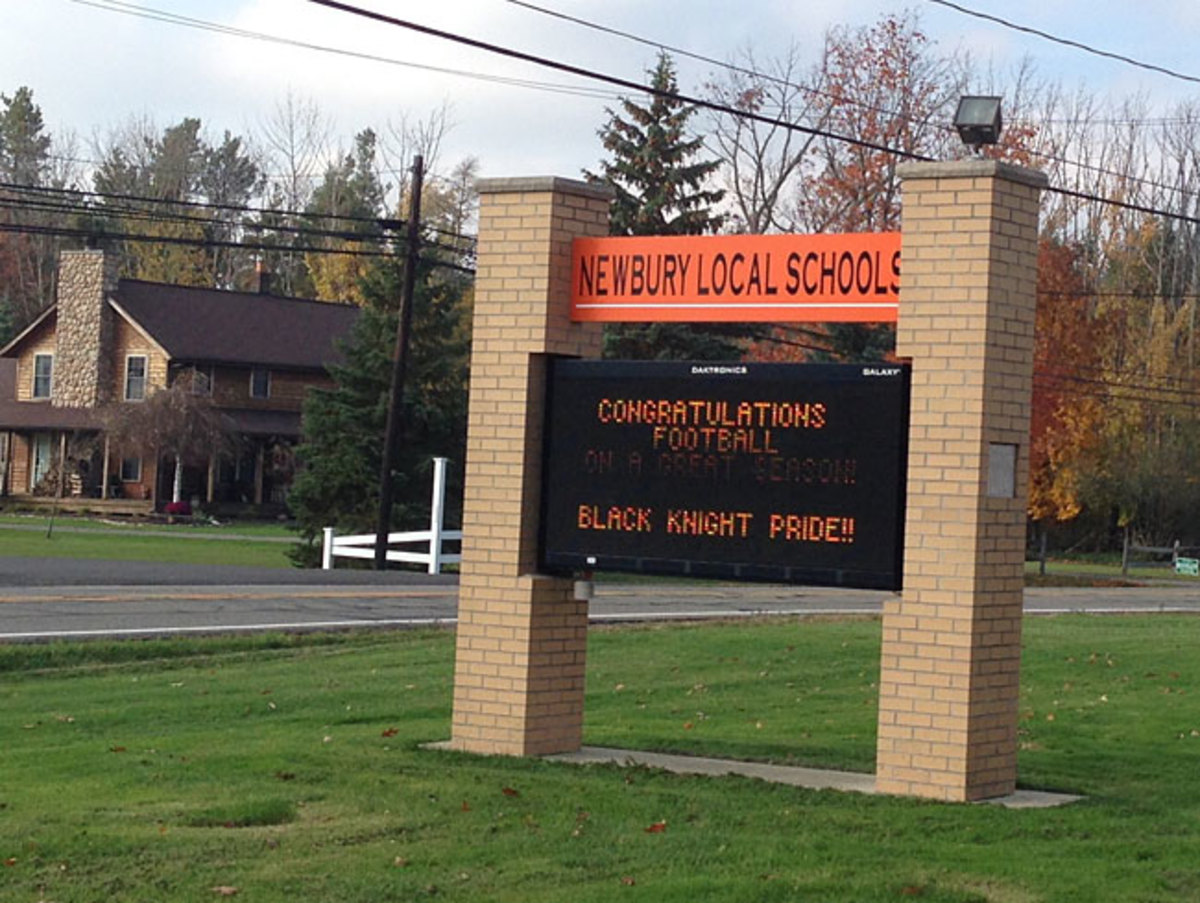
The problem with Newbury High—the Northeast Ohio program forced to shut down midseason—is that there is not one particular problem. Rather, the school did everything right. First understand the environment in which the school operates.
The school itself occupies a two-building campus that houses kindergarten through 12th grade. Some of the grades are as small as 25 students; the largest is around 50. Newbury does what it can in athletics considering its size: There is no girls’ soccer team, but three girls play on the boys’ team (and they do play). Some of the football players are also in the band, as are two cheerleaders. They preform halftime in their uniforms.
“Ohio is a hotbed for football, and in some ways football is the identity of a school,” Chaffee, the principal, said. “Think—football brings a band, cheerleaders, a meeting place for the community on Friday nights. Yes, we are small, but if it’s important to our students, we’ll try to make it happen. Our kids want football.”
But for the last five years, because of its size, Newbury has not fielded a middle-school team. That eventually affected football at the high school level. In August, 20 boys tried out for varsity. Three quit for various reasons, and the Black Knights began the season with 17 players—only one a senior and a handful who were brand-new to organized football. What’s more, two of the freshmen are so small that coaches hesitated to play them in a varsity game against more physical competition, and another two players have autism. Gladowski said those latter two are wonderful teammates, but from a safety perspective he would not feel comfortable putting them in certain games.
“Yes, we are small, but if it’s important to our students, we’ll try to make it happen. Our kids want football.”
In being inclusionary and trying to make its small roster work, Newbury demonstrated creativity. The offense ran the Wing-T. Situational drills were often shrunk to become micro-specific. (“Right side of the defensive line versus left side of the offensive line!”) There was no scout team, and Gladowski often scrimmaged himself as the opposing quarterback. (“Hey, you’re never going to face anyone as good as me!” the coach often joked with his players).
For seven weeks the Black Knights were able to get by, even though by the third quarter of each game the players, all of whom played both ways, were gassed. “They know they’re a small team, and they’re used to it,” Forfia, the athletic director said. “But they want to fight and keep playing. In that eighth game, safetywise, it just wasn’t going to happen.”
Of the five players who succumbed to injury in the game against Lutheran East, only one was possibly concussion-related. One player had a shoulder injury, three hurt their legs and the last had a back ailment. The fact that the Black Knights lasted seven weeks is something of a miracle.
Newbury is one of three Ohio schools that canceled its season midway through the year, according to Beau Rugg, the assistant commissioner of the Ohio High School Athletic Association. Four Los Angeles-area schools also nixed remaining games, and The MMQB found cases in Maine, New York, Wisconsin and Minnesota as well. Each school either did not have enough players try out, or saw its roster depleted as the season went on.
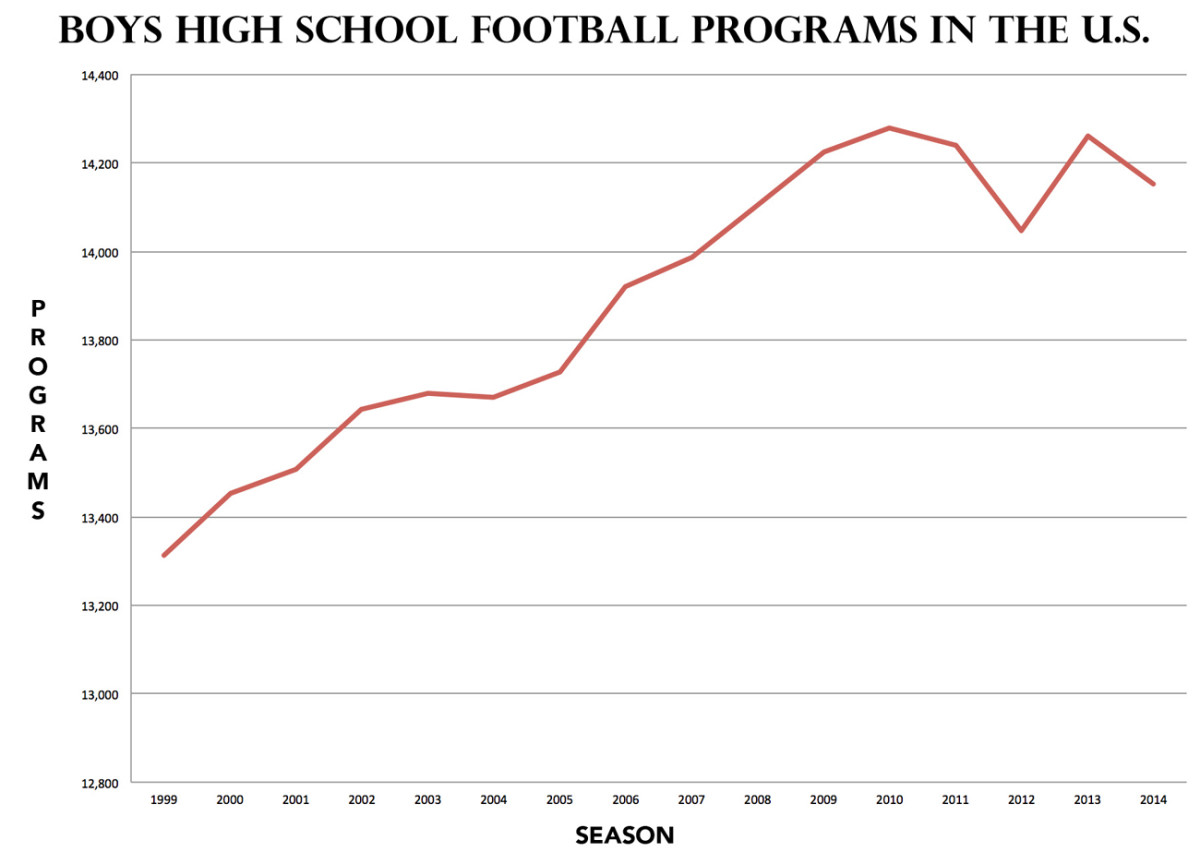
There are two possible solutions to depleted football rosters. One is to consolidate a smaller program like Newbury with another school. In Ohio, Rugg said, that has happened with wrestling (consider that a 135-pounder can’t even practice if his teammates are all in the 185-pound weight class). However, the size of football rosters can make this measure costly or unfeasible. Also, at places such as Newbury, where the closest opponent is a 45-minute bus ride away, it may be impractical.
Another option is to play a different kind of football. The OHSAA currently has a committee exploring possibilities with eight-man football (which is offered in 18 states, all of them west of the Mississippi). Said Rugg: “There’s a changing dynamic in this country, no doubt about it.”
• A MORAL DILEMMA: A high school coach rethinks the ethics of his sport
* * *
Watershed NFL moments such as the players’ concussion lawsuit and Chris Borland’s proactive retirement have seeped to the sidelines of high school football, becoming at the very least the subject of chatter among concerned parents.
But other elements that are trickling down to high school from the NFL, many believe, will make the sport safer at the youth level. One example is the banning of crown-of-the-helmet hits, which NFL players and other critics said would make the game “soft.” Birk was a league-and-union-appointed appeals officer during the first season of the rule, 2013. He saw first-hand how difficult it was for players to adopt the change—many said those type of hits were practically instinctive because that’s what they were taught—but over time he witnessed how their behavior changed. “By the end of that season you could literally see players trying to pull back,” Birk said, “and that was amazing.”
Said Rugg, the Ohio administrator who serves on the national rules committee: “Once you see something at a higher level, it takes time to filter down, but it does. The techniques and tackling that people are adhering to now, it helps if it’s reinforced at the NFL level.”
The second example is the attitude towards concussion. “Look at Luke Kuechly,” Birk said. “Ten, 20 years ago, how many coaches or fans would have accepted that the star linebacker of an undefeated football team should sit out three games to get his head right? Hopefully that attitude is setting the tone.”
With USA Football’s Heads Up initiative in its third year promoting educational programs for coaches, and equipment manufacturers in a race to build and sell ever-safer equipment (whether they’re overselling is another question), high school football does appear to be in a better place regarding health and safety.
However, not every NFL initiative correlates to the youth level, and the league’s resources far exceed those of high schools. For example, Blake, the California administrator, revealed a troubling statistic in his state: Only 19 percent of athletic programs have access to a trainer every day. “I think the most important thing moving forward with high school football is that we listen to science,” Blake said. “We listen to research and we move swiftly. It has been a tragic year with eight deaths. And although many might say that this is down from how many football-related deaths there were 10, 20 years ago, if that player is a player in your community, or your son, one is too many. But we can’t act emotionally. That’s not the answer.”
Back at Newbury High, it is a week after the cancellation of Lutheran East and emotions are less raw, more measured. While the reality of the football season’s early ending has been accepted, there is no talk of disbanding the program for next season. Outside Principal Chaffee’s window, the soccer team has poured on to the football field for practice. “It’s nice for a school to have a football team,” he said. “I’m not willing to say it’s a necessity, but if kids want to play, it’s our job as adults to figure out a way to help them do that.”
MORE MMQB: Peter King’s exclusive look at an NFL game plan—Part I | Part II
